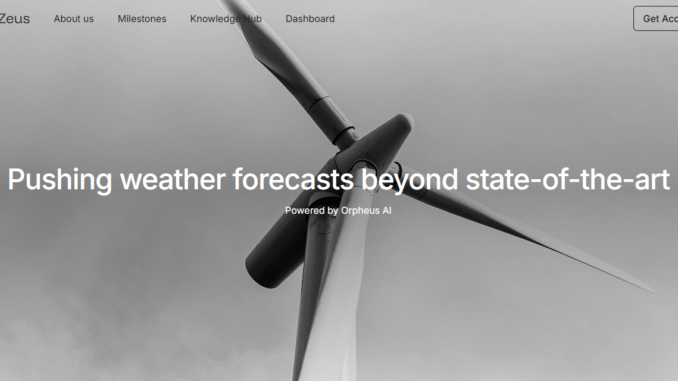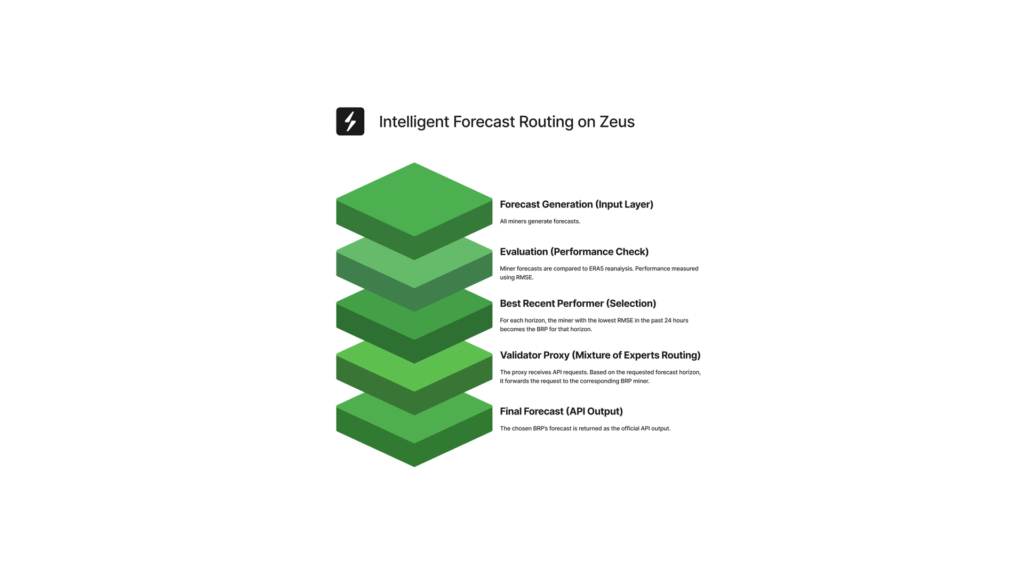
Weather affects our daily lives — whether it’s planning flights, predicting crop yields, or managing renewable energy. But traditional forecasting models often miss the mark, especially when conditions change quickly.
That’s where Zeus, a decentralized weather forecasting subnet built on Bittensor (SN18), comes in.
Zeus uses a unique system called the Best Recent Performer (BRP) to make forecasts more accurate and reliable.
What is BRP?
Think of BRP as a “performance spotlight.” For every forecast window, the system looks at all the miners (contributors running forecasting models) and identifies the one with the lowest average Root Mean Square Error (RMSE) — lowest error rate — over the past 24 hours.

That miner becomes the Best Recent Performer. The validator proxy then routes forecasts through that miner, ensuring users always receive predictions from the model that’s performing best at that moment. Not yesterday, not last week.
Zeus doesn’t gamble on outdated averages. It adapts in real time, selecting the miner with the freshest, most proven results.
The Study
To test how well BRP works, Zeus analyzed 615 forecasts over a 30-day period. The focus was on two critical variables:
a. Eastern wind speed at 100m altitude (used for aviation, energy, and climate studies).
b. Dewpoint temperature (a key factor in humidity, comfort, and crop health).
For accuracy, forecasts were checked against ERA5 reanalysis data from the EU’s Copernicus Climate Data Store (the gold standard for weather truth). Performance was also compared to Open-Meteo, which aggregates leading global weather models.
Results: Eastern Wind Speed

a. Average gains: 45.59% to 65.74% improvement over the baseline.
b. Peak performance: A 65.74% boost in the 2–3 day forecast window.
c. Lowest error: An RMSE of 0.89 in the 1–2 day window, showing excellent near-term precision.
Results: Dewpoint Temperature

a. Average gains: 39.66% to 66.13% improvement.
b. Peak performance: A 66.13% boost in the 5–6 day forecast window.
c. Lowest error: An RMSE of 0.28 in the 0–1 day window, highlighting exceptional short-term accuracy.
Why This Matters
The improvements aren’t just numbers, they’re real-world advantages useful in cogent decision-making process:
a. Pilots can plan safer routes with more accurate wind forecasts.
b. Farmers can predict crop conditions better with reliable dewpoint data.
c. Energy companies can optimize turbine and grid management with improved wind speed predictions.
By outperforming traditional models—even at longer forecast ranges—Zeus shows that decentralized, incentive-driven systems can rival or surpass centralized weather services.
Conclusion
The BRP metric proves that accuracy improves when forecasts are judged by recent, real-world performance rather than static models.
With gains often exceeding 65%, Zeus demonstrates how decentralized AI can deliver faster, smarter, and more reliable forecasts.
It’s not just a technical win—it’s a glimpse into the future of how weather, and perhaps many other fields, will be predicted: by networks that adapt, compete, and learn in real time.
Resources
Stay connected to Zeus Subnet via:
Website: https://www.zeussubnet.com
X (Formerly Twitter): https://x.com/zeussubnet
GitHub: https://github.com/Orpheus-AI/Zeus
Discord: https://discord.com/channels/799672011265015819/1335971614516576296
LinkedIn: https://www.linkedin.com/company/orpheus-ai/




Be the first to comment